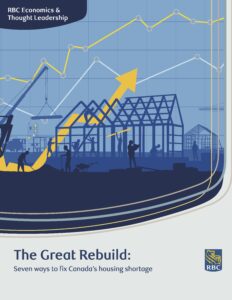
RBC Economics offers pragmatic housing solutions
By Adam Freill
Construction Leadership ResidentialWith Canada in the midst of a housing crisis, RBC report presents seven ways to address the country’s housing shortage.
Solutions to Canada’s housing crisis can’t come fast enough. More than half of the 1.9 million new households that will be created by 2030, approximately one million families, will not be able to buy a home if affordability remains close to where it is today, according to research from Royal Bank of Canada. Perhaps even more troubling is that more than 40 per cent of the new households that can’t buy a home will also not earn enough to afford rent at the market price.
To help address the issue, RBC Economics and Thought Leadership has released The Great Rebuild: Seven ways to fix Canada’s housing shortage. The report looks at the factors that led to Canada’s housing crisis and advances policy ideas to address it.
“The current affordability crisis has been driven by a massive undersupply of housing in the face of booming demand,” said Robert Hogue, assistant chief economist, RBC Economics. “Canada needs to significantly grow its housing stock, especially rental and affordable housing, and it needs to do so quickly. Addressing this challenge will require greater collaboration between governments, industry and other stakeholders.”
According to the report, the pace of housing construction would need to rise by significantly to meet future demographic growth. Housing completions have averaged 218,000 in the past three years, falling short of the estimated need for an annual average of 320,000 between 2023 and 2030, says RBC.
The report offers seven actions that the financial institution says will create the best path forward to bringing meaningful home price and rent relief.
- Aggressively expand the construction sector’s labour pool by prioritizing immigrant skills, recognizing credentials from other jurisdictions and setting ambitious targets for trade enrollments.
- Develop and adopt innovative designs, building techniques and technology to boost productivity through prefabricated housing and pre-approved building designs.
- Speed up housing project approvals by reducing regulatory requirements, harmonizing building codes and prioritizing projects with faster turnaround times.
- Ease zoning restrictions to allow more density in cities and diversify the types of houses built to make more productive use of land.
- Lower the cost of building new housing by using more cost-efficient materials and modulating government charges.
- Change the housing supply mix with incentives to build purpose-built apartments by waiving development charges and using publicly owned land.
- Expand the housing stock from within by reclaiming units from short-term rental businesses, making it easier to build secondary suites, and converting under-used non-residential buildings for residential needs.
“We’re working with Canadians across the country — homeowners, builders, policymakers — to help ensure home ownership remains part of the Canadian dream,” said John Stackhouse, senior vice-president, Office of the CEO, at RBC. “Efforts will have to go beyond what’s been done so far, and we hope these pragmatic ideas help rebalance supply and demand and do so in ways that continue to drive Canadian prosperity.”





